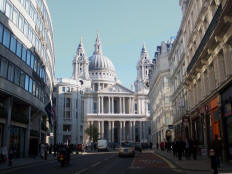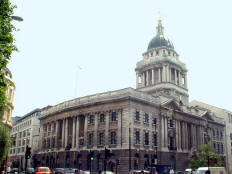Page 1 2 3 4 5 Tuesday, 9 May. By this time we had used up our reservation at the Columbia Hotel and had to check at the desk every morning to see if we could stay for another night. Fortunately, we
all were OK’d for another night, but the Browns had to move to a different room. After breakfast, the six of us took the subway to Westminster Bridge, where we boarded a boat for a cruise down the Thames to the Tower of London. The guide on the boat was very good. We learned that the old bridge usually thought of as the London Bridge (of "falling down" fame) was really the Tower Bridge. The London Bridge is just a plain, ordinary looking bridge, and it's not even the original bridge on this site. We also learned that the Tower of London is a large cluster of buildings surrounded by a wall and formerly a moat. We had thought of it as a single tower. 
Tower Bridge | 
The Tower of London | 
Model of the Tower of London |

Chopping block & axe |

Site of the chopping block |
One of the Beefeaters guided us around the Tower grounds. He made an exceptionally fine guide and could rattle off the names of all the many persons beheaded on the Tower chopping block. Although all of the Tower was very interesting, we were most impressed by the crown jewels. It is difficult to believe that diamonds really come as big as some of those, such as the Star of Africa (530 carats), set in the Royal Scepter. Another piece (317 carats) of the same original diamond is mounted on the front of the Imperial State Crown. (The original diamond weighed 3106 carats and was cut into nine separate gems.) 
The ladies with our beefeater guide | 
Beefeaters on a break | 
The Imperial State Crown |

St. Paul's Cathedral |
We had lunch at Ye Olde Tiger Tavern, "dating to 1500," right outside the Tower. Its longevity must be due to persistence rather than culinary achievements. We all walked through the East End, by the Bank of England, to St. Paul's Cathedral. Although very large and very beautiful, St. Paul’s completely lacks a proper setting. It's hemmed in by other large buildings, and it's very difficult to get a good photograph of the front. 
The Old Bailey |
At this point we left the Brown's and Jones' and walked up to Old Bailey, the famous criminal court. A case was being tried which involved fraud on creditors. Although the procedure is substantially the same as in the U.S., one major difference was immediately apparent. Everyone was so extremely polite, even the lawyers on cross examination and in addressing each other. The judge ran the court room absolutely, and the lawyers didn't try anything funny. When the defense lawyer made an aside remark for the benefit of the jury, the judge really chewed him out. We then walked
down Fleet Street into the oldest part of town, called the City. This was the original City of London and its boundaries are now marked on the main streets by statues of a mythical griffin. We saw St. Bride's Church, where Samuel Pepys was baptized, and Ye Olde Cheshire Cheese, a pub once frequented by Samuel Johnson, Oliver Goldsmith, and later Charles Dickens. We stopped for tea on Fleet Street, and returned to the hotel about 17:00. After dinner at the hotel with the Brown's and Jones', we all went to the Drury Lane Theater to see “My Fair Lady." It was terrific even though Henry Higgins, the male leading role, didn't have much of a voice. We took a cab right back to the hotel after the show. Page 1 2 3 4 5
Home
Copyright © 2000-2023 DarrellPeck.com All rights
reserved.
|